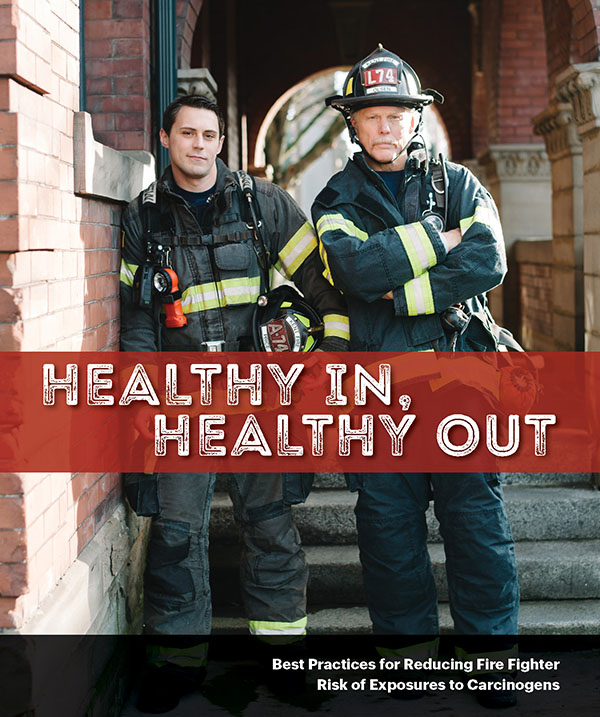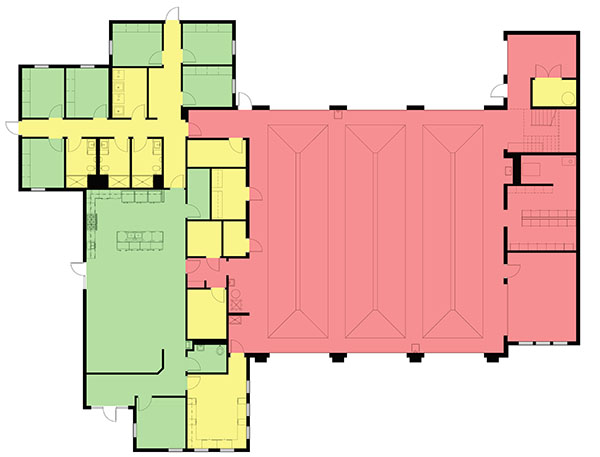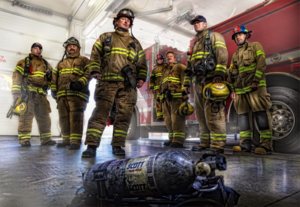Fire fighters and other first responders put their lives on the line every day to keep communities safe. As Architect and Engineers, it’s our duty to do all we can to design fire stations that support fire fighter health. In a previous blog post, I outlined how a well-designed fire station can support fire fighter health; passively and actively. The intent of this article is to go a bit deeper into those methods that go into healthy fire station design.

Quick Recap: The key methods fall into two basic categories: Passive and Active.
This article will focus on one of the Active methods.
*For additional related information, see the previous article titled “Designing Fire Stations that Keep Fire Fighters Safe”.
Active methods are those which are related to the building systems and the interior environment. Active methods include:
- Apparatus Exhaust Control
- Mass Extraction
- Direct Capture
- Combination of the above.
- Air Pressurization Zones
- High Contaminant Levels – Negative Pressure
- Intermediate Spaces – Neutral Pressure
- Low Contaminant Levels – Positive Pressure
- Direct Exhaust of Operational Support Spaces
- PPE (Personal Protective Equipment) / Turn-out Gear Storage
- Decontamination/Gear Extraction Rooms
- Maintenance Workshops
Apparatus Exhaust Control:
One of the most easily containable sources of contaminants in a fire station is apparatus exhaust and yet it is also the one that is most often overlooked. Perhaps it’s the misperception that because the large apparatus bay doors are open that enough ventilation is being provided, however, the danger goes beyond the presence of the exhaust contaminants in the air. Whether during turn-out, return from a fire event, or during routine maintenance, apparatus engines will be running within the apparatus bay. Once the exhaust contaminants are in the air, they can and often will settle on any surface within the apparatus bay. Those contaminated surfaces then become contaminant sources themselves. Going a step further, oftentimes there are doors that open from the apparatus bay into the living areas of the station. During turn-out, those doors will directly introduce exhaust contaminants into the air within the station itself, further increasing exposure.

The three most common ways of dealing with exhaust contaminants are:
- Mass Extraction – a station-based solution that utilizes large exhaust fans and ductwork within the apparatus bay to extract the contaminated air from the apparatus bay and exhaust it to the exterior of the building.
- For stations in warm climates, this can provide beneficial cooling to the apparatus bays by extracting and exhausting warm stale air.
- For stations in cold climates, this can present a challenge as it extracts and exhausts all that money has been spent to heat, leading to potentially higher utility bills in winter and causing energy to be wasted.
- Direct Capture – a solution that captures the contaminants at the source, the apparatus tailpipe. Direct Capture systems can be either:
- Station Based
- These systems consist of nozzles which attach to apparatus exhaust pipes either pneumatically/mechanically or magnetically, capturing the exhaust into flexible ducts connected to rooftop exhaust fans and which utilize rail systems to allow apparatus to exit the apparatus bay with the nozzle attached, breaking away only as the apparatus exhaust reaches the end of the rail.
- Station-based systems may have a greater upfront cost, but they also have a lower life-cycle cost as they are only installed once, require relatively little in the way of maintenance and work even in stations where apparatus is shared or changed.
- Apparatus Based
- These systems consist of filters that connect into the apparatus exhaust system and divert contaminants into the filter for a programable duration which allows the apparatus time to exit the apparatus bay before moving the diverter back and allowing exhaust to flow and bypass the filter.
- Apparatus based systems may have a lower upfront cost, but they require modification to the apparatus, typically require regular maintenance to ensure they are operating correctly/efficiently and go where the apparatus goes which could pose potential problems where apparatus may be shared and not all are equipped with such a system.
- These systems consist of filters that connect into the apparatus exhaust system and divert contaminants into the filter for a programable duration which allows the apparatus time to exit the apparatus bay before moving the diverter back and allowing exhaust to flow and bypass the filter.
- These systems consist of nozzles which attach to apparatus exhaust pipes either pneumatically/mechanically or magnetically, capturing the exhaust into flexible ducts connected to rooftop exhaust fans and which utilize rail systems to allow apparatus to exit the apparatus bay with the nozzle attached, breaking away only as the apparatus exhaust reaches the end of the rail.
- Station Based
The choice of a system that is best for your station is one that is critical to the health of both fire station and the fire fighters who call that station home.
For new fire station construction, a station based, direct capture system is often the best choice as it can accommodate apparatus changes and grow to meet the needs of the department’s ever-evolving mission.
For existing fire stations, a station based, the direct capture system can dramatically improve the overall health of the station by greatly reducing, if not eliminating one of the main contaminant sources within a station. Where such systems are not practical/possible due to budgetary concerns or physical constraints, apparatus based direct capture systems offer a more cost-effective option, at least over the short term.
Mass extraction systems can be used alone, depending on your climate and other considerations, or can be used in conjunction with the direct capture systems to provide an additional level of protection and contamination control. As always, the goal is to establish a balance between supporting fire fighter health and operational efficiency of the station which must ultimately serve the department’s mission. This balance is essential since any design or design element that hampers the operation of the station will not be sustainable over time and will ultimately be pushed aside. A successful design will adapt these methods to work with and in support of the department’s operational goals, thereby helping to ensure their longevity.
If you have any questions relating to the Active methods above feel free to contact us for more information.








